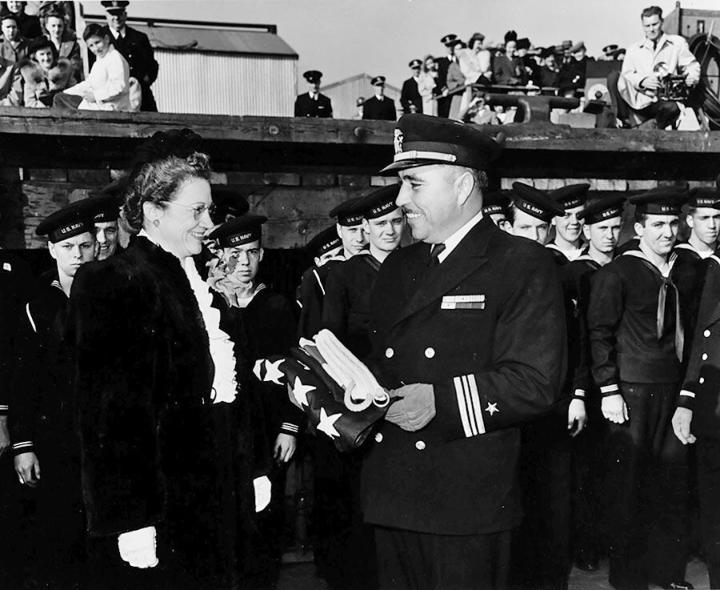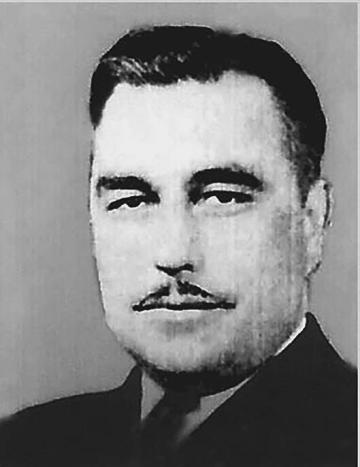 |
Canku Ota
|
 |
|
(Many Paths)
|
||
|
An Online Newsletter
Celebrating Native America
|
||
|
April 2021 - Volume
19 Number 4
|
||
|
|
||
|
Sunken Ship Commanded
By Cherokee Found In Pacific
|
||
|
by Will Chavez - Assistant
Editor Cherokee Phoenix
|
||
Editor's note: Though it has been published before that Earnest Evans is Cherokee, it has been determined by a Cherokee genealogist that Evans is not enrolled in the Cherokee Nation. MUSKOGEE – On April 1, the U.S. Navy, working with the company Caladan Oceanic, located the wreck of the USS Johnston in 21,000 feet of water off the Philippine island of Samar. The ship was lost during the Battle of Samar and was commanded by Cherokee Nation and Muscogee (Creek) Nation citizen Earnest Edwin Evans. As commander of the USS Johnston, his aggressive nature and bravery helped win the battle against the Japanese navy in October 1944. Evans was born in Pawnee in 1908 and graduated from Muskogee High School in 1926. He graduated from the Naval Academy in 1931. The USS Johnston was a 2,100-ton destroyer built in Seattle and was commissioned on Oct. 27, 1943. The day the Johnston was commissioned, Lt. Cmdr. Evans told his crew, "This is going to be a fighting ship. I intend to go in harm's way, and anyone who doesn't want to go along had better get off right now." After the discovery of the USS Johnston, Caladan announced no human remains or clothing were seen during the dives to the wreck and nothing was taken from the wreck. "The wreck of the Johnston is a hallowed site," said retired Read Adm. Sam Cox, who is head of the Naval History and Heritage Command in Washington, D.C. Evans and his crew were active in the Pacific in 1944, participating in the Marshalls, Marianas, Palaus and Leyte campaigns. On May 15, while operating in the Solomons Islands, the Johnston assisted in sinking a Japanese submarine. In October 1944, it was time for the USS Johnston and her crew to fulfill their destinies. The Japanese command believed that if the Philippines were lost then so was the war. They drew up a desperate plan that risked their remaining navy forces, but offered them a remote chance of destroying the American invasion fleet and isolating the Allied ground forces on Leyte. On Oct. 25, the Johnston was one of seven destroyers forming a protective screen around three groups of carriers off Samar when a Japanese task force appeared that included four battleships, seven heavy cruisers and nine destroyers and an 80,000-ton battleship, the largest ever built at that time. The Johnston and other destroyers fought a furious rear-guard action to allow the carriers to run to safety. The Johnston's gunnery officer later reported, "We felt like little David without a slingshot." For the first 20 minutes, the Johnston was helpless as the enemy cruisers and battleships had her in range. But the destroyer's 5-inch guns could not yet reach them. Amazingly, the enemy gunners could not score a hit on the Johnston. As soon as range closed to within 10 miles, the Johnston opened her 5-inch battery on the nearest cruiser, the Kumano, scoring damaging hits. In five minutes, the Johnston pumped more than 200 shells at the enemy, then Evans ordered, "fire torpedoes." The destroyer got off 10 torpedoes then whipped around to hide behind a heavy smoke screen. When she came out of the smoke a minute later, the Kumano could be seen burning from a torpedo hit; its bow had been blown completely off. The Johnston had taken three 14-inch shell hits followed closely by three 6-inch shells that hit the bridge. The hits resulted in the loss of all power to the steering engine and all power to the three 5-inch guns in the aft (rear) part of the ship. The bridge was abandoned, and Evans had lost two fingers on his left hand. The Johnston had spent all of its torpedoes but continued making simulated torpedo runs to fool the Japanese ships, and the crew kept up fire from the ship's five 5-inch guns. At 7:50 a.m. the Johnston had one engine and could not keep up with the other American destroyers, but Evans ordered his men to provide fire support. At 8:20 a.m., out of the smoke, a 30,000-ton Kongo-class battleship appeared only 7,000 yards off the Johnston's port (left) beam. The battleship lobbed a few shells at the smaller destroyer but missed. The Johnston soon observed the carrier Gambier Bay under fire from an enemy cruiser. Evans ordered his men to fire on the enemy cruiser to draw her fire away from Gambier Bay. The Johnston scored four hits then broke off as a Japanese destroyer squadron was seen closing rapidly. The Johnston outfought the Japanese destroyer squadron, concentrating on the lead ship until the enemy quit, then concentrated on the second destroyer until the remaining enemy ships broke off to get out of gun range. After regrouping, the Japanese cruiser and destroyers opened fire on the Johnston, and when it was most needed, the remaining engine quit, leaving the Johnston dead in the water after three hours of battle. The enemy ships closed in for an easy kill, pouring fire into the crippled destroyer.
At 9:45 a.m. Evans gave the order to "abandon ship." At 10:10 a.m. the Johnston rolled over and began to sink. A Japanese destroyer pumped a final shell into her to make sure she went down. Though she was lost in this action, along with most of her crew, the Johnston's efforts were instrumental in saving most of the carriers and preventing the Japanese fleet from reaching an American invasion area. From the Johnston's complement of 327 men, only 141 were saved. Of 186 lost, about 50 were killed by enemy action, 45 died on rafts from battle injuries; and 92, including Evans, were alive in the water after the Johnston sank but were never heard from again. He was posthumously awarded the Medal of Honor, the nation's highest military honor. "Seriously wounded early in the engagement, Cmdr. Evans, by his indomitable courage and brilliant professional skill, aided materially in turning back the enemy during a critical phase of the action. His valiant fighting spirit throughout this historic battle will venture as an inspiration to all who served with him," stated his Medal of Honor citation. In 1971, two bronze plaques were presented to Muskogee High School in his honor. One plaque bears the text of the Medal of Honor citation describing the battle in which he died. The other plaque has Evans' picture and name. "The skipper was a fighting man from the soles of his broad feet to the ends of his straight black hair. He was an Oklahoman and proud of the Indian blood he had in him. The Johnston was a fighting ship, but he was the heart and soul of her," said an unidentified Johnston crewman. As the Caladan ended its expedition, the project's research vessel came to a stop, sounded its whistle, and a memorial wreath was placed on the ocean, the company said. Sources: Cutler, Thomas, "The Battle of Leyte Gulf: 23-26 October 1944," Naval Institute Press, 2001 Hornfischer, James D., "The Last Stand of the Tin Can Sailors: The Extraordinary World War II Story of the U.S. Navy's Finest Hour," Bantam, 2005 National WWII Memorial – List of Medal of Honor Recipients |
|||||
|
|
|
||
|
|
||
| Canku Ota is a free Newsletter celebrating Native America, its traditions and accomplishments . We do not provide subscriber or visitor names to anyone. Some articles presented in Canku Ota may contain copyright material. We have received appropriate permissions for republishing any articles. Material appearing here is distributed without profit or monetary gain to those who have expressed an interest. This is in accordance with Title 17 U.S.C. Section 107. | ||
|
Canku Ota is a copyright ©
2000 - 2021 of Vicki Williams Barry and Paul Barry.
|
||
 |
 |
|
|
The "Canku
Ota - A Newsletter Celebrating Native America" web site and
its design is the
|
||
|
Copyright ©
1999 - 2021 of Paul C. Barry.
|
||
|
All Rights Reserved.
|
||


